
The “historic” regulation with deep footnotes
One of the most discussed topics in Armenian media in the past few weeks was the issue of the Aug. 30 regulation on the joint activities of the Commission on State Border Delimitation and Border Security and the State Commission on State Border Delimitation between Armenia and Azerbaijan, which was ratified at the Government session on Sept. 5.
Different approaches were presented in relation to the topic, however, along with all this, it is very important to understand what the aforementioned document actually is, what is behind it, and why it appeared on the table of Armenian-Azerbaijani relations at this very stage. Let us add that in this regard, Nikol Pashinyan clearly stated in the Parliament that the mentioned regulation will serve as a base.
Basically, what happened by the authorities and their propagandists is presented to the public as a very important, even “key document”, which allows us to assume that it is not that reasonable to consider it pro-Armenian. The core of the document, as was repeatedly emphasized in Pashinyan’s speech, is the Alma-Ata Declaration, under which the parties recognize each other’s territorial integrity, according to the 1991 USSR maps.
Additionally, the Declaration is a document that does not solve and does not regulate border problems; it is a declaration about other states joining the CIS; it has nothing to do with the creation of the CIS. Pashinyan has distorted and blurred this topic so much that people do not know what the Alma-Ata Declaration is, the basis of which is the Belovezha Accords according to which Russia, Ukraine and Belarus create the CIS. The irony of the situation lies in the fact that the Alma-Ata Declaration has nothing to do with the border of any state.
Moreover, that declaration, as such, did not impose any international legal obligations on Armenia toward Azerbaijan, because Azerbaijan was not a CIS member until Sept. 24, 1993. In addition, the provision of respect for the territorial integrity and inviolability of borders established in the Declaration has nothing to do with the question of what the present borders between the CIS member states are and what territory this or that state covers (the CIS member states recognized each other’s borders only by the CIS Charter adopted on Jan. 22, 1993—to which Azerbaijan was not a party).
That said, initially the agreement was signed by three states in Belarus. Other republics in Alma-Ata actually joined that agreement. A new document was not actually concluded. It is a political declaration of a general nature, in which, of course, there are no details and cannot be. Alma-Ata being a political document, there are no maps, there are no clear records of what borders and geographical areas are actually being talked about, besides, there is no mention of any episode of fixing the state border in the text.
We can state that Nikol Pashinyan did everything in order to finally have the opportunity to refer to the Alma-Ata Declaration. For this quite painful concessions were made, ceding territories regularly. In the text of the regulation, it is written in black and white that it is also possible that Alma-Ata is not referred to in the main document. In other words, this document also contains Pashinyan’s cheap manipulation, when everything is not specified, but is presented with allegories. Such a settlement is extremely dangerous, as it allows Azerbaijan to avoid accepting the border existing at the time of the collapse of the Soviet Union as a starting point.
Another logical question arises: With what borders does Azerbaijan recognize the territorial integrity of the Republic of Armenia according to the Alma-Ata Declaration; if it recognizes the state border of the Republic of Armenia of 1991, then on what ground have the Azerbaijani troops been in the sovereign territory of the Republic of Armenia for exactly two years or what kind of Bacchanalia was created in Tavush under the name of border delimitation? By the way, after Oct. 6, 2022, when Azerbaijan announced that it recognized the territorial integrity of Armenia, it never once noted which borders it was talking about (contrary to Aliyev, several times a day Pashinyan talks about the 86,6000 square kilometers).
Another important and rather dangerous part is the fact of “segmental delimitation” fixed in the regulation, which is a huge minefield embedded in the border establishment process. It is particularly risky here that when a clear section is not specified, i.e. there is no map basis, there is no guarantee that the Azerbaijani side will not have another demand and, for example, will not present a new map as the basis of border delimitation (the occupied part of Jermuk, the section of Nerkin Hand and the Goris-Kapan roads in this regard remain an open issue). Here it is very important to state that in this situation we are talking about the so-called enclaves and exclaves. As a result, Azerbaijan can avoid border delimitation activities in the areas that are under Azerbaijani occupation.
So far, the Armenian authorities have not spoken and have not demanded that Azerbaijan withdraw its troops from the sovereign territory of Armenia, while these are territories of strategic importance, because they have direct control over the logistics systems of Armenia (M2 interstate highway).
Summing up, let us add that Pashinyan is in a hurry to have documents in his hands, on one of which will be written “Demarcation of the borders of the Republic of Armenia”, and on the other one “Peace Treaty”, in order to have a “dobro” [green light] from his patrons to be re-elected once again and to extend his political career one more stage. And what will be written in those documents is of little concern to the Pashinyan’s supporters.
Armen Hovasapyan


